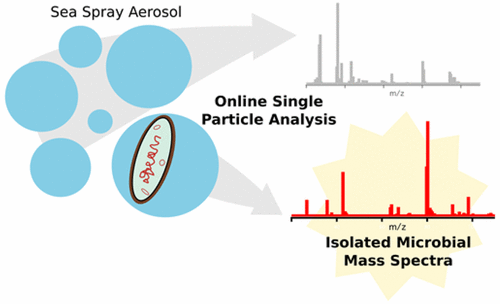当前位置:
X-MOL 学术
›
Anal. Chem.
›
论文详情
Our official English website, www.x-mol.net, welcomes your
feedback! (Note: you will need to create a separate account there.)
Expanding Single Particle Mass Spectrometer Analyses for the Identification of Microbe Signatures in Sea Spray Aerosol
Analytical Chemistry ( IF 6.7 ) Pub Date : 2017-09-22 00:00:00 , DOI: 10.1021/acs.analchem.7b00933 Camille M. Sultana 1 , Hashim Al-Mashat 1 , Kimberly A. Prather 1
Analytical Chemistry ( IF 6.7 ) Pub Date : 2017-09-22 00:00:00 , DOI: 10.1021/acs.analchem.7b00933 Camille M. Sultana 1 , Hashim Al-Mashat 1 , Kimberly A. Prather 1
Affiliation

|
Ocean-derived microbes in sea spray aersosol (SSA) have the potential to influence climate and weather by acting as ice nucleating particles in clouds. Single particle mass spectrometers (SPMSs), which generate in situ single particle composition data, are excellent tools for characterizing aerosols under changing environmental conditions as they can provide high temporal resolution and require no sample preparation. While SPMSs have proven capable of detecting microbes, these instruments have never been utilized to definitively identify aerosolized microbes in ambient sea spray aersosol. In this study, an aerosol time-of-flight mass spectrometer was used to analyze laboratory generated SSA produced from natural seawater in a marine aerosol reference tank. We present the first description of a population of biological SSA mass spectra (BioSS), which closely match the ion signatures observed in previous terrestrial microbe studies. The fraction of BioSS dramatically increased in the largest supermicron particles, consistent with field and laboratory measurements of microbes ejected by bubble bursting, further supporting the assignment of BioSS mass spectra as microbes. Finally, as supported by analysis of inorganic ion signals, we propose that dry BioSS particles have heterogeneous structures, with microbes adhered to sodium chloride nodules surrounded by magnesium-enriched coatings. Consistent with this structure, chlorine-containing ion markers were ubiquitous in BioSS spectra and identified as possible tracers for distinguishing recently aerosolized marine from terrestrial microbes.
中文翻译:

扩展单粒子质谱仪分析海喷雾气溶胶中微生物特征的鉴定
海洋喷雾气溶胶(SSA)中的海洋微生物可能通过充当云中的冰核颗粒而影响气候和天气。单粒子质谱仪(SPMS),可原位生成单颗粒成分数据是在不断变化的环境条件下表征气溶胶的出色工具,因为它们可以提供高的时间分辨率并且不需要样品制备。尽管SPMS已被证明具有检测微生物的能力,但是这些仪器从未被用于确定性地识别周围海洋喷雾气溶胶中的气溶胶化微生物。在这项研究中,使用了一个气溶胶飞行时间质谱仪来分析实验室产生的SSA,该SSA是从海洋气溶胶参考罐中的天然海水中产生的。我们目前对生物SSA质谱(BioSS)的种群进行了首次描述,它与以前的陆地微生物研究中观察到的离子特征非常匹配。在最大的超微粒子中,BioSS的比例急剧增加,与通过气泡破裂喷射的微生物的现场和实验室测量结果一致,进一步支持将BioSS质谱指定为微生物。最后,作为对无机离子信号分析的支持,我们提出干燥的BioSS颗粒具有异质结构,微生物粘附在富含镁的涂层周围的氯化钠结核上。与此结构一致,含氯离子标记物在BioSS光谱中无处不在,并被识别为可能的示踪剂,用于区分最近雾化的海洋生物和陆地微生物。微生物附着在富含镁的涂层周围的氯化钠结核上。与此结构一致,含氯离子标记物在BioSS光谱中无处不在,并被识别为可能的示踪剂,用于区分最近雾化的海洋生物和陆地微生物。微生物附着在富含镁的涂层周围的氯化钠结核上。与此结构一致,含氯离子标记物在BioSS光谱中无处不在,并被识别为可能的示踪剂,用于区分最近雾化的海洋生物和陆地微生物。
更新日期:2017-09-22
中文翻译:

扩展单粒子质谱仪分析海喷雾气溶胶中微生物特征的鉴定
海洋喷雾气溶胶(SSA)中的海洋微生物可能通过充当云中的冰核颗粒而影响气候和天气。单粒子质谱仪(SPMS),可原位生成单颗粒成分数据是在不断变化的环境条件下表征气溶胶的出色工具,因为它们可以提供高的时间分辨率并且不需要样品制备。尽管SPMS已被证明具有检测微生物的能力,但是这些仪器从未被用于确定性地识别周围海洋喷雾气溶胶中的气溶胶化微生物。在这项研究中,使用了一个气溶胶飞行时间质谱仪来分析实验室产生的SSA,该SSA是从海洋气溶胶参考罐中的天然海水中产生的。我们目前对生物SSA质谱(BioSS)的种群进行了首次描述,它与以前的陆地微生物研究中观察到的离子特征非常匹配。在最大的超微粒子中,BioSS的比例急剧增加,与通过气泡破裂喷射的微生物的现场和实验室测量结果一致,进一步支持将BioSS质谱指定为微生物。最后,作为对无机离子信号分析的支持,我们提出干燥的BioSS颗粒具有异质结构,微生物粘附在富含镁的涂层周围的氯化钠结核上。与此结构一致,含氯离子标记物在BioSS光谱中无处不在,并被识别为可能的示踪剂,用于区分最近雾化的海洋生物和陆地微生物。微生物附着在富含镁的涂层周围的氯化钠结核上。与此结构一致,含氯离子标记物在BioSS光谱中无处不在,并被识别为可能的示踪剂,用于区分最近雾化的海洋生物和陆地微生物。微生物附着在富含镁的涂层周围的氯化钠结核上。与此结构一致,含氯离子标记物在BioSS光谱中无处不在,并被识别为可能的示踪剂,用于区分最近雾化的海洋生物和陆地微生物。










































 京公网安备 11010802027423号
京公网安备 11010802027423号